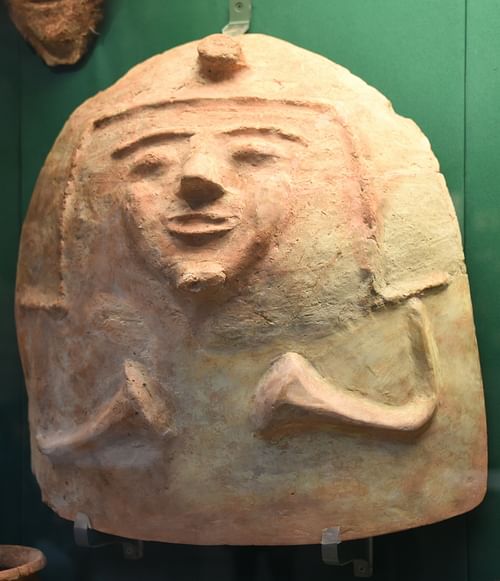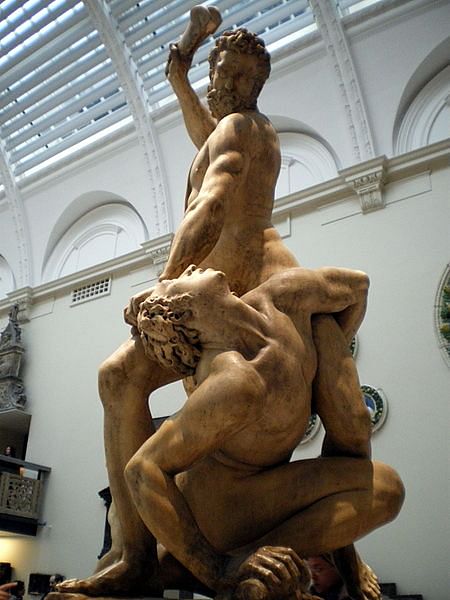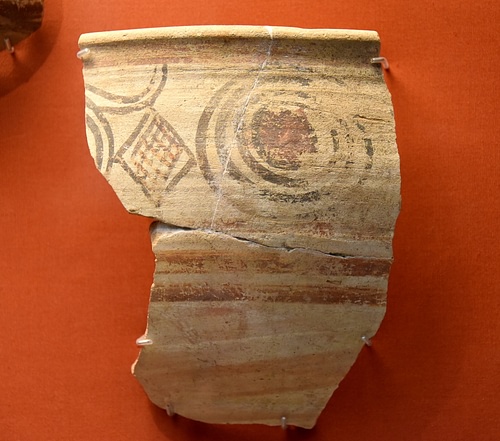
The Philistines populated the coastal regions of Canaan from the 12th century BCE to their disappearance in 604 BCE. The word "Philistine" derives from the Hebrew ha-Plištim for the combination of several tribes of Syria and Judea with the older name "Syria-Palestina". The Latin word for the lands of Canaan became "Palestine" after the Bar-Kochba Revolt (132-136 CE) during the reign of the Roman emperor Hadrian (r. 117-138 CE). The term "Philistine" has come to mean someone uneducated and lacking in culture from the stories concerning them in the Jewish Scriptures.
Origins
The origins of the Philistines remain the subject of scholarly debate. In the Hebrew Bible, there is an indication that they originated in Crete. The Septuagint (the Greek translation of the Hebrew Bible) also connects them to Crete. This provides an Aegean origin, but other scholars have suggested Anatolia (Turkey) or regions around the Black Sea. On the other hand, they could have originated as a break-off tribe within Canaan itself. In the excavation of Philistine cities in Israel, the cemeteries revealed a mixed gene body of local, Semitic traits with European gene pools. The latter could indicate a migration into the region.
During the transition from the Late Bronze Age to the Iron Age, in 1143 BCE, the Eastern Mediterranean was overcome by a simultaneous invasion of traders, designated the Sea Peoples in various countries. This upended traditional trade patterns and partners. At the same time, iron weapons were introduced as well as chariots in certain regions. At the mortuary temple of Pharaoh Ramesses III at Medinet Habu, Ramesses claimed to have defeated the Sea Peoples and drove them out of Egypt. The wall sculpture depicts the Sea peoples drowning in the sea battle with others in the typical Egyptian portrayal of prisoners with their hands tied behind them.
Referring to them as the Peleset, there is also the Harris Papyrus, which tells the story of how they were "reduced to ashes." During the New Kingdom (c. 1570 to c. 1069 BCE), Egypt had conquered and ruled the southern Levant, and there is an indication that some prisoners were then settled in the coastal areas of Canaan.
The Book of Judges/1 Samuel
The Sea Peoples are designated Philistines in the biblical books of Judges and 1 Samuel where they are considered the greatest enemies of Israel. When the Israelites emerged in Canaan (in the Iron Age II level), a tribal confederation – the Twelve Tribes of Israel (the sons of Jacob) – was created. The Philistines also formed a confederation of five cities: Ashkelon, Ashdod, Ekron, Gath, and Gaza. Thus, this region became known as the Gaza Strip.
The Book of Judges relates the story of how the folk hero Samson often defeated the Philistines. When Samson was born, his mother placed him under a Nazirite vow, which meant that he was to be separated from normal society and devote himself to God (Numbers 6:1-21). This included not cutting one's hair, and the vow endowed him with great strength, for example, one time he slew the Philistines with the jawbone of an ass.
Samson was not the best model of a Nazirite, and he was taken up by a Philistine woman, Delilah, who nagged him into revealing the secret of his hair. She cut his hair as he slept, and his Philistine captors blinded him. He was placed in a dungeon, and at a festival for their god, the Philistines brought him out of prison to mock him as entertainment. However, during his captivity, Samson's hair grew back, and he grabbed two pillars and brought down the building, killing many Philistines.
In the opening chapters of 1 Samuel, the situation worsens. Eli, the high-priest at that time, recalling how the Israelites took the Ark of the Covenant into battle, suggested taking the Ark the next time the Philistines attacked. Not only did the Israelites lose but the Ark was also captured by the Philistines. They placed it in the temple to the god Dagon. However, every morning the statue was found on the ground. A blight destroyed their crops and a plague resulted so that the Philistines realized that this was not such a prize after all. They took it back to a field near the Israelite army lines and left it there with gold offerings.
The scene shifts to what is known as the story of the Rise of David. Realizing that a tribal confederation could not defeat the Philistines, the people asked Samuel, a Prophet, to give them a king: "Then we will be like all the other nations, with a king to lead us and to go out before us and fight our battles" (1 Samuel 8:20). This was considered an evil as they were told at Sinai not to be like the other nations. Nevertheless, Saul was chosen, but he turned out to be a bad king. Samuel went to Bethlehem and poured oil on the head of the youngest son of Jesse, David. From the Hebrew 'anointed," the term became "messiah," "the anointed one."
King David
David’s older brothers were at the front lines fighting the Philistines. He took food there for his brothers, and that is when he found out that the Philistines had made an offer to settle matters. They would send out their champion, the giant Goliath. The Israelites should choose a champion, and the duel would settle matters. David was appalled that no Israelite had volunteered. He said he would do it, and they placed Saul's armor on him and then mocked him because it was too big. David then took a sling, not a slingshot; slings were long leather strips with a stone attached to the end. They were whirled above the head and then slung as ballista to the enemy lines. David hit Goliath in the middle of the forehead causing him to fall. David then beheaded Goliath with his own sword.

Later in the story, Saul became jealous of David and chased him from the court because David was more successful at defeating the Philistines. The people chanted: "Saul has slain his thousands and David his tens of thousands" (1 Samuel 18:7). On the run, David and his followers often sold themselves as mercenaries to the Philistines, but the Philistines would never let David fight against the Israelites (they could not trust him). When Saul met the Philistines at the battle of Mount Gilboa, both he and his son Jonathan were killed. The tribes then declared David king of a united monarchy.
Archaeological Excavations
Archaeologists have excavated many of the cities associated with the Philistines in Israel, as well as some sites in the Jezreel Valley further north. The material evidence includes large halls, like the earlier Mycenaean megaron, a large hall with a central hearth and throne. Early Philistine pottery resembles the Aegean/Mycenaean pottery that was decorated with shades of brown and black.
The Leon Levy Expedition, consisting of scientists from several universities, excavated the Philistine cemeteries. One contained 150 bodies dating from the 11th to the 8th century BCE. The investigation included DNA studies. Their conclusions found that the Philistines were not native to the area but had similar burial practices to earlier Aegean cultures, where some were buried in round stone-lined tombs which were not indigenous to Canaan. We know little concerning the language of the Philistines. Some pottery fragments have non-Semitic inscriptions. A few Philistine words and names are associated with Indo-European terms (which also could have been learned from Aegean/Greek culture).
The excavations revealed evidence of town planning and a well-defined olive and wine industry. Two hundred olive installations have been found, as well as breweries, wineries, and shops to distribute these wares. The Philistines were experts in metallurgy (utilizing gold, bronze, and iron) and the production of weapons. Even the Israelites applied to the Philistines for their iron tools and weapons.
Religion
The gods and goddesses of the Philistines included Baal, Astarte, Asherah, and Dagon. The names and characteristics of these deities are also elements of the Canaanite religion. The archaeological material has uncovered common goddess figures seated on chairs which again was an Aegean element in goddess worship.
The importance of the excavations is that by bringing all this material culture together, we find that Philistines were not uneducated or lacking culture. It was quite the opposite. The Philistines had a rich artistic culture, a diversified economy, and shared many of the elements of the worldviews of their neighbors.
Demise
The Philistines began their decline with the invasion of the areas of Canaan by the Neo-Assyrian Empire in 722 BCE. When the Assyrian King Sargon II (r. 722-705 BCE) invaded Philistia, Egypt promoted and funded rebellions against the Assyrians. In the next ten years, Sargon's son, Sennacherib (r. 705-681 BCE) put down all rebellions and destroyed their cities. Jerusalem held out, but it was later destroyed by the Babylonians in 587 BCE. This is the last we hear of the Philistines.













